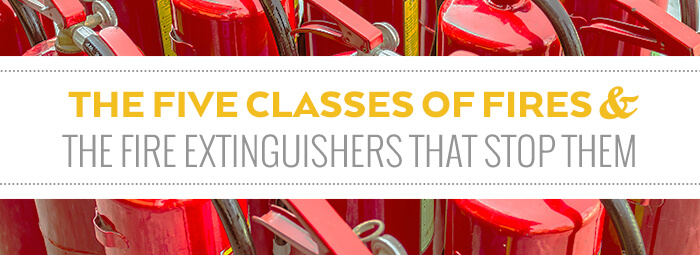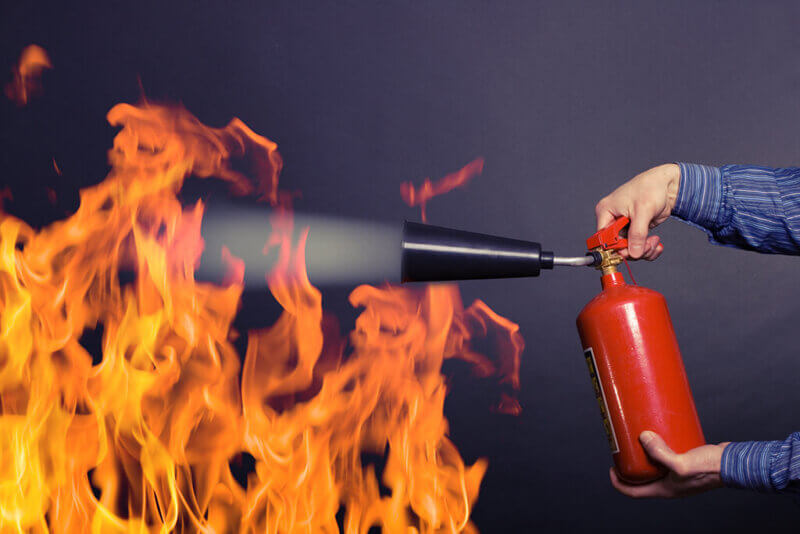
When you run a business, you are responsible for the safety of your employees and guests. A large part of safety is being prepared for accidents and emergencies such as a fire. You may believe that you are prepared if you have a fire extinguisher on site, but you may not be as prepared as you think.
The common fire extinguisher is one of the most well known and widely used safety tools. However, you cannot buy the first fire extinguisher you see and expect it to keep your business safe. Every business is different and so are the potential dangers they face.
Fire extinguishers are specialized pieces of equipment that are designed to put out fires of different classes. Fire extinguisher ratings are based on the five classes of fires. Do you have the right fire extinguishers for your unique risks?

When buying fire extinguishers for your business, it’s important to buy the right type of fire extinguisher for your needs. There are several different classifications of fires based primarily on the fuel source. Every fire extinguisher is rated for the types of fires it’s effective in putting out. By understanding what each fire class means, you can understand which fire types are a safety hazard at your business. Once you are aware of what types of fires your business may encounter, you can buy the proper extinguisher for protecting against them.
Class A fires are defined as ordinary combustibles. These types are fires use commonly flammable material as their fuel source. Wood, fabric, paper, trash ,and plastics are common sources of Class A fires. This is essentially the common accidental fire encountered across several different industries. Trash fires are one such example. Class A fires are commonly put out with water or monoammonium phosphate.
The Class B fire is defined as one that uses a flammable liquid or gas as its fuel base. Common liquid based fuel sources include petroleum based oils and paints, kerosene, and gasoline. Flammable gases such as butane or propane are also common fuel sources in Class B fires. Class B fires are a common hazard in industries dealing with fuels, lubricants, and certain types of paint. Smothering these types of fires to remove oxygen is a common solution as are chemical reactions that produce similar effects. Note that cooking fires have their own classification and are defined as Class K fires.
The Class C fire is defined as a fire that uses electrical components and/or energized equipment as its fuel source. Electrical fires are often fueled by motors, appliances, and electronic transformers. Electrical fires are common in industries that deal with energy or make use of heavy electrically-powered equipment. However, electrical fires can occur on smaller scales in all businesses (i.e. an overloaded surge protector or bad wiring) and should be taken seriously. To extinguish such fires you cut the power off and use non-conductive chemicals to extinguish the fire.
The Class D fire is defined as one that uses a combustible metal as its fuel source. Examples of such combustible metals include titanium, magnesium, aluminum, and potassium. Note that there are also other metals with combustive properties you may encounter. Class D fires are a danger in laboratory environments. However, be aware that combustible metals are used as part of production and other industry processes, and you need to be certain of what materials you are using for day-to-day operations. When confronted with such a fire, common extinguishing agents such as water are ineffective and can be hazardous. To extinguish a Class D fire, use a dry powder agent. This absorbs the heat the fire requires to burn and smothers it as well.
A Class K fire is defined as a cooking fire involving combustion from liquids used in food preparation. Technically a type of liquid fire, Class K fires are distinct enough to warrant their own classification. Cooking fires are fueled by a wide range of liquid cooking materials. Greases, cooking oils, vegetable fat, and animal fat are all fuel sources found in Class K fires. Class K fires are naturally of concern in the food service and restaurant industry. Such fires can be very dangerous and far more destructive than you may think. Wet chemical fire extinguishers have become popular in putting out these types of fires.
It is very important to have the right tool for a job. Fire extinguishers are no different. By being aware of the five classes of fires, you can be sure that you are purchasing safety equipment that will be effective should an accident or emergency occur.